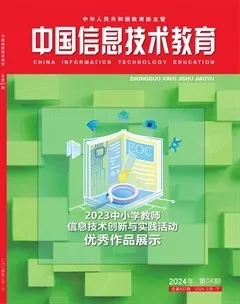发展语言能力 培育文化意识
李伶俐
创新整合点
①本节课应用了互动课堂、畅言智慧课堂等软件,及时掌握学生的学习情况,评价也更具时效性。随机抽人、当堂点评加分等功能的使用,使学生的注意力更集中,学生更具参与感。小组评价使小组之间的学习氛围更加浓厚,充分调动了学生的学习积极性。
②借助互动课堂的当堂检测功能,发送当堂检测小练习给学生,学生在学生端进行自主答题;通过学生的答题情况统计,反馈出学生对知识点的掌握情况,适时调整教学策略,做到精准教学。运用作品上传的功能,教师可以对学生的作业进行实时评价,使对学生的评价反馈更具时效性,在师生共同的欣赏交流中,学生参与课堂的积极性更高。
③借助畅言智慧课堂的智能语音评测技术,掌握学生对所学单词的读音掌握情况,示范朗读、对比朗读激发学生的学习兴趣,让学生主动参与到活动中。同时,该技术还可以实时纠正学生的发音,帮助学生快速掌握发音技巧,促进学生语言能力的发展。
教材分析
Unit 4 School part 1a,1b是外研社版英语Join in三年级起点四年级上册第四单元中的学习内容,本单元内容围绕学校这一主题展开。本节课是本单元的第一课时,情境属于“人与自我”主题范畴中“生活与学习”这一主题群,通过看图片、听录音、回答问题及口语表达等形式,学习有关School的单词及句子,运用所学语言就看到的图片内容与他人进行交流,描述和介绍学校场所和场所功能,然后再来介绍自己的学校,从文本迁移到实际生活,表达自己对校园和学校生活的情感和态度。
本课重点在于通过运用语言和非语言知识以及相关策略,使学生参与到School主题的语言活动中,发展其语言理解和表达能力,培育文化意识。
学情分析
经过三年级的英语学习,四年级的学生已具备一定的单词和句型基础,能用简单的句型对某个事物进行描述。School这个话题贴近学生实际生活,内容丰富有趣,通过学习能让学生学会用英语语言去描述自己的学校以及表达对学校的热爱。在本册书的第二单元In the classroom,学生已经初步了解过“Is there…?”和“Are there…?”的句型及相关回答,但是还停留在看图片、回答问题的层面,无法熟练使用There be句型来描述某地有某物。
学生初步学会利用新媒体技术手段,如操作平板、在学生端进行答题、语音评测、上传作业等,体验了信息技术与课程学习结合带来的乐趣与成就感。
本课以新视角“英语学习活动观”来设计英语课堂教学,将教学活动分成学习理解、应用实践和迁移创新三大层级的活动,帮助解决不同层次的学生面临的语言学习问题,使课堂教学活动具有符合认知规律的层次性。
教學目标
知识与技能目标:①能正确读出、规范书写单词gym,library,playground,canteen,computer room,classroom,并理解单词的意思。②能在教师的指导下运用It is a….It is….There is/are….等句型描述学校的一些地方。③能在教师的指导下运用Is your…big (small)?Yes,it is./No,it isn't.Is there …?/Are there…?等句型进行简单的交际,并完成1b部分的书上练习。
过程与方法目标:在看、听、说的活动中,获取、梳理对话中学校各个场所的信息,能互相简单交流学校信息。
情感态度与价值观目标:用所学语言介绍自己学校的布局、各功能室的设置以及陪伴自己成长的老师与同学,表达对学校、对校园生活的喜爱。
教学环境与准备
教学环境:互动课堂教学平台、畅言智慧课堂、宽带网络、触控一体机、学生平板。
教学准备:学生初步掌握新媒体技术,如操作平板、语音评测、学生端答题、拍照上传作业等。在充分复习并巩固There be句型、Is/Are there…?一般疑问句及其回答的基础上进入新课学习。
教学过程
Step1.Warming up
T(Show a picture):What’s this?
Ss:It’s our classroom.
T:What’s in the classroom?
S1:There is a blackboard.
S2:There are many desks and chairs.
S3:There are two doors and five windows.
T:Good job.Let’s enjoy a short video together and find out what’s in this classroom.Here we go.
T:After watching the video,please finish the task.
在观看完视频后,教师向学生端发送当堂检测练习,学生在平板上完成练习,并提交。教师通过答题统计,可以掌握学生作业提交情况及每道小题的正确率。
T:Our classroom is big and beautiful.There are many things in the classroom. We have different classes in our classroom.Where is our classroom?
Ss:At our school.
T:Great.This lesson we’ll learn Unit 4 School.
设计意图:播放一段有关What’s in the classroom?的小视频,帮助学生复习巩固There be句型的一般疑问句及其回答。借助互动课堂的当堂检测功能给学生端发送相关练习,通过答题数据统计,教师可以掌握学生对Is/Are there…?句型回答的熟悉程度,再由classroom引出本单元的主题school。
Step2.Presentation
Activity 1: Look at the picture and answer.
①Who are they?(Pit and Pat)
②Where are Pit and Pat?(They are at school)
③Is their school big/beautiful?(Yes, it is)
Pit and Pat’s school is big and beautiful.What’s in their school?
设计意图:这一环节将学生熟悉的课本人物Pit和Pat置于学校情境中,创设school的语言情境,激发学生的学习兴趣,使学生积极主动参与到学习中来。
Activity 2: Let’s look, listen and learn.
①Look,This is their____.(classroom)
Is their classroom clean?(Yes,it is)
What can we do in the classroom?(We can sing songs, draw pictures,study English…)
We have different classes here.
②That is their_____ .(computer room)
Are there many computers in the computer room?(No,there aren’t)
There aren’t many computers in the computer room.=Their school hasn’t got many computers.
What can we do in the computer room?(We can have computer class)
③Their school has got a _____.(library)
Are there many books here?
(Yes,there are)
There are many books in the library.
Their library has got many books.
We can read books in the library.
④This is their _____ .(playground)
What do they often do here?
They play football on the playground.
⑤They’ve got a ____,too.(gym)
What’s the difference between gym and playground?
Gym is inside.Playground is outside.
⑥Their school has got a ____.(canteen)
What do the children do here?
They have lunch in the canteen.
设计意图:本环节通过介绍Pit和Pat的学校,学习学校场所的单词,运用图片帮助学生理解单词的意义,通过音频帮助学生掌握单词的发音。同时,将学校场所的图片与单词卡片粘贴在黑板上,学生通过回答问题及句型理解,进一步理解学校场所的功能,内化语言。
Activity 3:Let’s read and match.
教师出示单词卡片和学校场所的图片,随机挑人认读单词,再给学生端发送任务,学生在平板上完成图片与单词配对的练习,并提交。教师运用互动课堂的答题统计,了解学生对单词意义的掌握情况。
设计意图:在单词学习理解完后,设计活动操练巩固单词的意义,运用多媒体技术,调动多感官,让学生积极主动参与到学习活动中,以此来提高学习效率。
Activity 4:Let’s read the words.
教师随机挑人,让学生上台朗读单词,运用畅言智慧课堂的智能语音评测功能,当堂检测学生的发音情况。
设计意图:本环节通过畅言智慧課堂的人工智能语音识别技术,让学生朗读所学新单词,智能检测学生的发音,以此来掌握学生的发音情况。该软件可以根据学生的朗读情况,及时发出评价,让学生学习兴趣增加。
Activity 5:Let’s play a guessing game.
I can play computers here.(computer room)
I can read books here.(library)
We can have lunch here.(canteen)
We can play football or basketball here.(playground)
We can have classes here.(classroom)
设计意图:这个游戏旨在帮助学生学习核心语言,学生在教师的指导下,归纳总结各个学校场所的功能,操练句型,为后面的语言输出环节做铺垫。
Activity 6: Let’s look, listen and answer.
①Whose school is it?(It’s the children’s.)
②Is their school big or small?(It’s small.It isn’t big.)
③What do they think of the school?(It’s not big.It’s small but cool.)
设计意图:这一环节,通过看文本图片、听录音及回答问题,帮助学生初步理解文本内容,再用形容词引导学生说一说,能让学生更加清楚地理解如何描述学校。
Activity 7: Let’s look, listen and point.
What’s in their school?(There is…)
设计意图:运用放大镜的动画功能,让学生边认读图片边用句型进行描述,在教师的指导下,进一步理解文本内容,内化语言,为语言输出奠定基础。
Activity 8: Let’s listen and answer the questions.
①Is their school big?(No./No,it isn’t.)
②Is it small?(Yes./Yes,it is.)
③Are there many classrooms?(No./No,there aren’t.)
④Is there a library? (Yes./Yes,there is.)
⑤Are there many books in it?(Yes./Yes,there are.)
⑥Is there a gym at the school?(Yes./Yes,there is.)
设计意图:学生通过前面的教学活动,对文本上的内容已经熟悉,该活动旨在让学生在理解文本的基础上,回答问题。通过一般疑问句的简略回答和完整回答,让学生熟练掌握此语法点。
Activity 9: Let’s listen and read in roles.
Tips:①Read loudly and emotionally.②Help each other.
G&B:Hello! Welcome to our school!
G:Our school isn’t big.It’s small.Look,this is our classroom.It’s big and clean.Our school hasn’t got many classrooms.
B:Look,that’s our computer room.We have got a big library,too.There are many books.
G:That’s our playground.It’s big.There is a gym in our school,too.Look here,please.This is a canteen.We all have lunch at school.
G&B:Our school is cool!We love it.
设计意图:两人一组,分角色扮演,朗读对话内容。通过角色扮演使每位学生都能深入角色,内化语言。
Step3.Practice
T:Look at the picture and talk about the school.Please take your exercise paper and fill in the blanks.
Hello,welcome to our school.Our school isn’t big.It’s small and clean.
This is our classroom.It's We can
That is our computer room.It's We can
We've got a library.It's
We can
That's our playground.It's We can
There is a gym.It's We can
This is a canteen.It’s We can
Our school is cool.We love it.
小组合作,以小组为单位,完成作业单上的填空练习,并拍照上传到互动课堂。教师通过随机抽人的方式,将挑选到的小组答案投射到屏幕上,并让该小组的成员上台进行展示,教师引导学生对小组表现进行评价,同时对学生表现及时反馈。
设计意图:本阶段学习活动引导学生在归纳和整理核心语言的基礎上,通过分角色朗读,让学生运用语言理解意义。基础较好的学生还可以尝试用自己的语言描述学校各个场所,并介绍场所功能,促进语言内化,从学习理解过渡到应用实践,为后面的真实表达做准备。
Step4.Extension
T(Show some pictures):Look at the pictures. Which school is it?
Ss:It’s our Dong Hulu School.
T:Yes, it’s our school.Is our school big?
Ss:Yes, it’s big and beautiful.
T:What are in our school?(Show some pictures)Can you talk about our school?
(Describe our school with sentences.)
Our school is ….This is…That is…There is/are…It’s big/small/clean/beautiful…We’ve got…
教师随机挑人,学生根据图片及句型,描述自己的学校。
T:There are many other places in our school.(Show pictures)
Is our school beautiful?Do you love our school?Why?
设计意图:本环节学习活动旨在帮助学生在迁移的语境中,创造性地运用所学语言,介绍自己学校的场所及功能。学生从课本走向现实生活,在介绍学校、描述学校以及场所功能的过程中,发展语用能力。学生在描述和介绍的过程中,表达自己对学校生活的情感及态度。
Step5.Homework
①Write and spell the new words.
②Talk about Rita and Mike's school.
③Talk about our school with your classmates.
设计意图:在作业设计环节,根据学生不同的语言基础水平,设计了三个作业,其中第一个和第二个是必做题,是本节课所学的重点内容,第三个是选做题,培养学生的语言交际能力,要求更高,这样设计是针对不同层次的学生,有的放矢。
教学反思
智慧课堂能帮助教师更及时地掌握学生的学习情况,课堂评价也更具时效性。与传统的课堂教学模式相比,智慧课堂使师生之间的互动更加深入。不过,智慧课堂也要求教师精准把控时间,所以在进行设计教学时,教师要注意每一环节问题设置的有效性和时效性,以免浪费教学时间。

